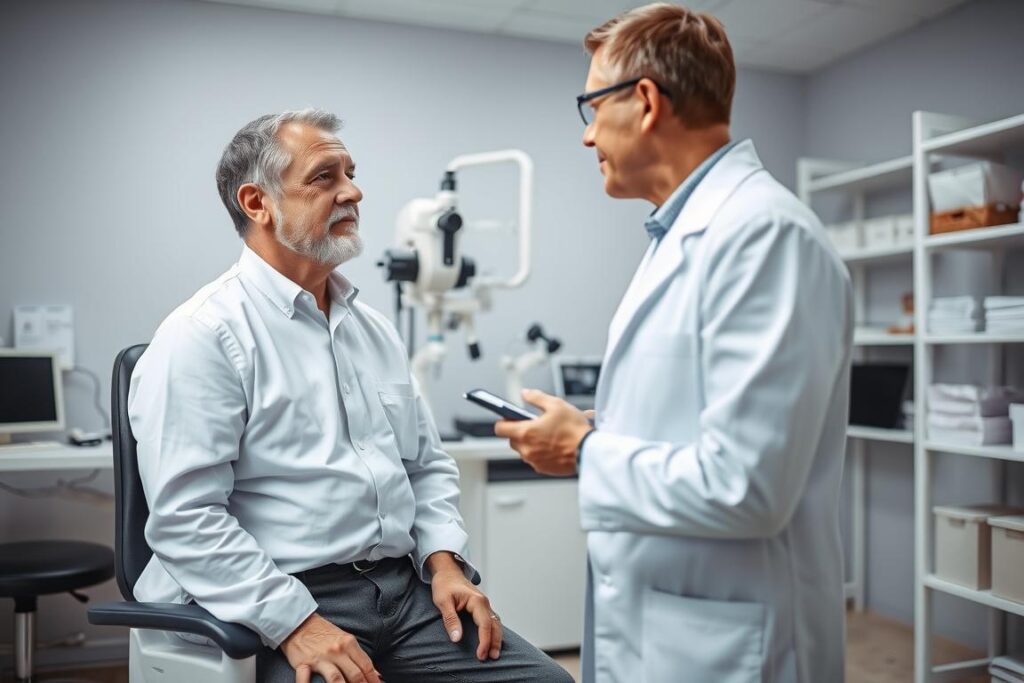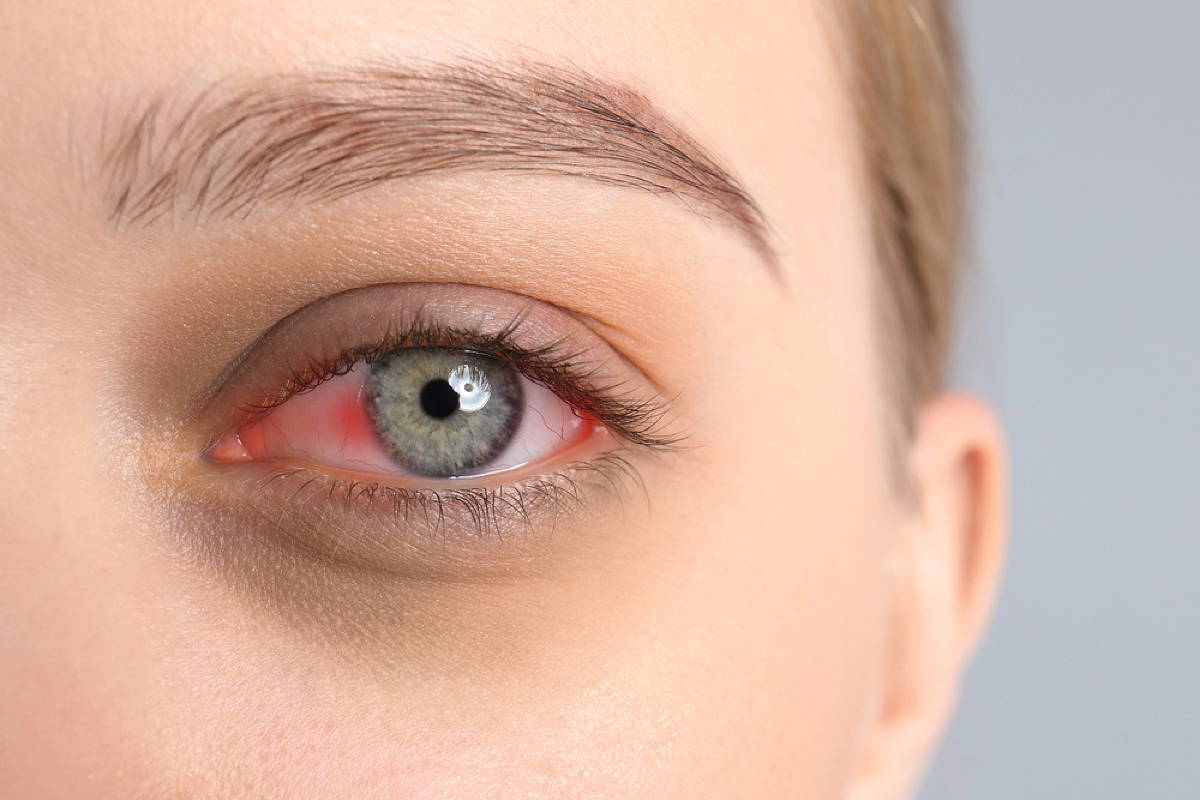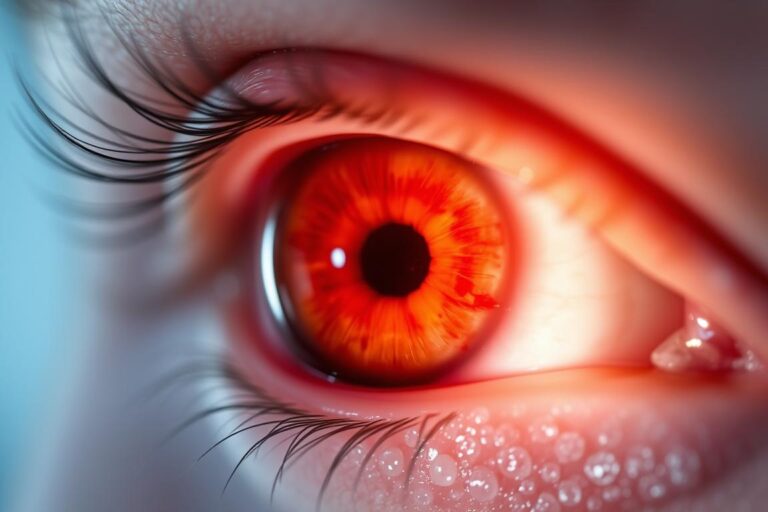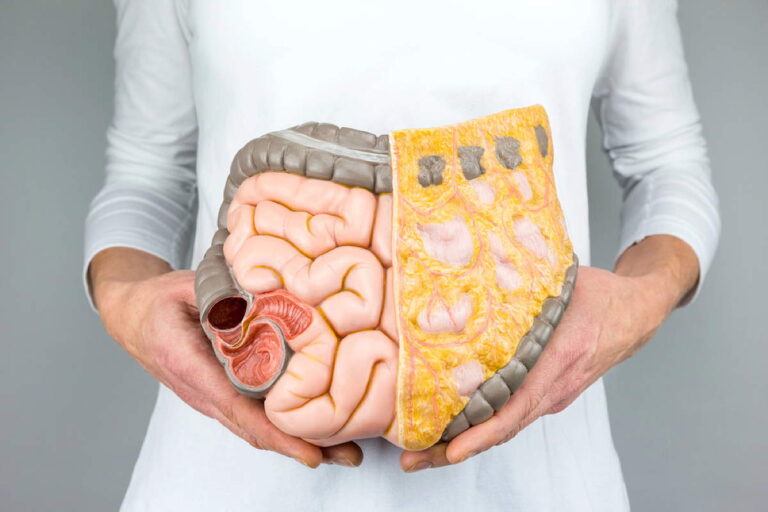What to do about dry eyes? The best tips for healthy eyes
One in ten people in Germany suffers from dry eyes. The symptoms are varied: some eyes feel tired and heavy, others are red, burning and itchy.
If you suffer from these symptoms, you are not alone. In this article, you will find out how the tear film works and what causes may be behind your symptoms.
You will receive practical tips on proper eyelid margin hygiene and how to protect your eyes when working at a screen. We will introduce you to both medical treatment options and tried-and-tested home remedies that can help alleviate your symptoms.
What are dry eyes and how do they feel?
Dry eyes are a condition where there is not enough tear fluid to keep the eyes healthy. If your eyes are dry, it can be very uncomfortable and cause various symptoms.
Recognize typical symptoms
Typical symptoms include redness, a burning or sandy sensation and a feeling of pressure on your eyes. You may also feel a foreign body sensation, as if there is a grain of sand in your eye.
Understanding the paradox of tears
Paradoxically, dry eyes can also lead to watery eyes. Your body tries to compensate for the chronic irritation by producing more tears. However, this reaction is not effective as the quality of the tears is not sufficient to properly moisturize the surface of the eye.
Other signs may include blurred vision, sensitivity to light and difficulty wearing contact lenses. It is important to recognize these symptoms in order to take appropriate action.
The importance of the tear film for healthy eyes
The tear film plays a crucial role in the health of your eyes. It is a wafer-thin protective film that provides your eyes with moisture and protects them from irritants.
Structure and function of the tear film
The tear film consists of three important layers: a mucous inner layer, a watery middle layer and an outer lipid layer. The mucous layer ensures that the tear fluid is evenly distributed on the surface of your eye.
- The aqueous middle layer contains important nutrients, enzymes and antibodies that protect your eyes from infections.
- The outer lipid layer slows down evaporation and stabilizes the entire tear film.
Why an intact tear film is important
An intact tear film is crucial for supplying your cornea with oxygen and nutrients, as the cornea has no blood vessels of its own. Correct vision is only possible with a healthy tear film, as it keeps the surface of your eyeball smooth and supple.
What to do about dry eyes? The most common causes
If you suffer from dry eyes, it is important to know the causes so that you can take targeted action. Dry eyes can be caused by a variety of factors.
Internal factors: diseases and hormonal changes
Internal factors play a significant role in the development of dry eyes. Diseases such as diabetes, thyroid problems and skin conditions (e.g. neurodermatitis or rosacea) can affect tear production. Hormonal changes, such as those that occur during the menopause, pregnancy or when taking the contraceptive pill, can also affect the production of tear fluid.
External factors: environmental influences and lifestyle habits
External factors include environmental influences such as dry indoor air, air conditioning and heating air, which can destabilize the tear film. Your lifestyle habits also play a major role: prolonged screen time leads to reduced blinking, which impairs the tear film. Wearing contact lenses and taking certain medications can also contribute to dry eyes.
When should you see an ophthalmologist?
If you suffer from dry eyes, it’s important to know when to see an expert. Dry eyes can have various causes and in some cases professional diagnosis and treatment is required.
Alarm signals that you should not ignore
There are certain symptoms that indicate that you should see an ophthalmologist. These include
- Persistent or worsening symptoms
- Pain in the eye
- sudden redness or deterioration of vision
What to expect during the examination
During your visit to the ophthalmologist, you can expect a comprehensive examination. The doctor will record your symptoms, pre-existing conditions and risk factors and examine your eyes thoroughly, including the facial and eyelid skin, blink frequency, eyelid closure and the eyelid margin glands.

Medical treatment options
If you suffer from dry eyes, there are various medical treatment options that can help you. These options aim to alleviate your symptoms and improve your eye health.
Artificial tears and eye drops
Artificial tears and tear substitutes are the basis of therapy and help to moisturize your eye surface and stabilize the tear film. There are different types of eye drops, such as aqueous drops, gels and ointments, as well as oily drops and sprays.
Anti-inflammatory preparations
For chronic conditions, cortisone or cyclosporine A drops can help reduce inflammation. These preparations are prescribed by your doctor and can provide an effective solution for your dry eyes.
Inflammation of the eyelid margin (blepharitis) as a cause of dry eyes
If you suffer from dry eyes, blepharitis could be the cause. Blepharitis is a chronic inflammation of the eyelid margin glands that is often associated with dry and inflamed eyes.
How blepharitis affects your eyes
This inflammation is often caused by an excessive proliferation of bacteria or mites on the edges of your eyelids, which can lead to itching, redness and a foreign body sensation. The meibomian glands, which are responsible for producing the oil layer of your tear film, are particularly affected.
Modern treatment methods such as BlephEx
One modern treatment method is BlephEx therapy, which uses special micro-sponges to gently remove deposits, bacteria and mites from the edges of your eyelids. This treatment can bring significant improvements after the first application and helps to keep your eyelid margin glands healthy.
Effective home remedies for dry eyes
If you suffer from dry eyes, there are some effective home remedies that can provide relief. Dry eyes can be caused by various factors and it is important to treat them properly.
Natural compresses and poultices
Some home remedies can help to relieve dry eyes. For example, black tea compresses can have an anti-inflammatory effect and soothe irritated eyes. The tannins in black tea can relieve swelling and relax the eye area. „The cooling effect of cucumber helps to soothe irritated eyes and counteract dryness,“ is a tried and tested home remedy.
Proper nutrition for healthy eyes
A balanced diet is important for the health of your eyes. Omega-3 fatty acids, for example in fish such as tuna or salmon, can improve the quality of your tear film. Good hydration supports natural tear production and prevents dryness. Make sure you drink enough water to keep your body and eyes healthy.
A few other tips can help you avoid dry eyes. Avoid hot spices, alcohol and caffeinated drinks, as these can have a negative effect on your body’s water balance.
Daily eyelid margin hygiene: how to do it right
Regular eyelid margin cleaning is essential to keep your eyes healthy. Good eyelid margin hygiene helps to keep the Meibomian glands functioning properly and prevent dry eyes.
Step-by-step instructions
For effective eyelid margin care, you should first warm your eyelids for around 5-10 minutes using warm compresses, for example a warm, damp washcloth. Then gently massage the skin at the base of your eyelashes to stimulate the glands.
Recommended products
Special products such as mild cleansing solutions or pre-soaked pads that are free from irritants are available for daily eyelid margin care. Make sure that you rinse your hands and all materials used thoroughly with water after cleaning.
Ideally, perform this routine twice a day to achieve optimal results and keep your eyelids healthy.
Digital eye stress: protection during screen work
Digital eye strain is a common problem in today’s screen-dominated world. Spending a lot of time in front of a screen can lead to dry eyes and other eye problems.
Apply the 20-20-20 rule
A simple and effective way to protect your eyes is to apply the 20-20-20 rule. Every 20 minutes, you should look at a point about 6 meters away for at least 20 seconds. This relieves the strain on your eye muscles and gives your eyes a chance to rest and moisturize.
Ergonomic settings for your workplace
An ergonomic design of your workstation can also help to protect your eyes. Make sure your monitor is tilted slightly downwards and about an arm’s length away from you. The top edge of the monitor should be at eye level or slightly below so that you can look down slightly, which encourages blinking and better moisturizes the eye surface.
- Long periods of screen time can lead to dry eyes, as you blink less often when you are concentrating on the monitor.
- Regular blinking exercises during work can help to keep your eyes moist.
- Special screen filters or blue light filter glasses can reduce the strain on your eyes and make viewing more comfortable.
Optimal indoor climate for your eye health
An optimal indoor climate is crucial for the health of your eyes. Dry air can accelerate the evaporation of tear fluid and lead to dry eyes.
Set the humidity and temperature correctly
The optimum humidity for your eyes is between 40 and 60 percent. The ideal room temperature is around 20-22°C. With a humidifier, you can actively provide more moisture in the air and thus relieve the strain on your eyes.
Dealing with air conditioning and heating air
Air conditioning is particularly problematic for dry eyes as it removes moisture from the air. Don’t set them too cold and never point the airflow directly at your face. Regular ventilation is important to improve air quality, but avoid draughts that hit your eyes directly.
Long-term strategies for healthy, moist eyes
Keeping your eyes healthy in the long term requires a comprehensive approach that takes into account various aspects of your lifestyle. Drink enough water, about 1.5-2 liters per day, to keep your body and therefore your tear production hydrated.
Daily eyelid margin care is particularly important if you already suffer from dry eyes or belong to the risk groups. Also make sure you eat a balanced diet with sufficient omega-3 fatty acids and vitamins to support the function of your tear glands.
You should also regularly check your medication with your doctor, as some medicines can cause dry eyes as a side effect. You can use these strategies to keep your eyes healthy and reduce discomfort.






